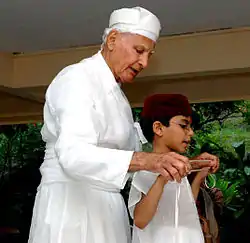Kushti
Kushti (/ˈkuːʃtiː/ also: Kusti, Koshti) is the sacred girdle worn by Zoroastrians around their waists. Along with the Sedreh, the Kushti is part of the ritual dress of the Zoroastrians.[1][2]
| Part of a series on |
| Zoroastrianism |
|---|
 |
|
|

The Kushti, formerly known as Zonnar, is worn wound three times around the waist. It is tied twice in a double knot in the front and back, the ends of the Kushti hanging on the back. The Kushti is made of 72 fine, white and woolen threads, which represent the 72 chapters of the Yasna, the primary liturgical collection of texts of the Avesta. The Avestan term for the sacred thread is "aiwyaongana". Kusti is the later Pahlavi term.[3]
The ritual of untying and tying the Kushti is performed several times a day and is called Nirang-i Kushti. During this ritual, the individual must remain standing in one spot, and may not speak to anyone. If the individual speaks, the ritual must be recommenced.
There is some evidence to suggest that the such girdles were worn by non-Muslims in general, including Christians.[4] An exception to this would be the nominally Muslim Mughal Emperor Akbar the Great, who was invested with a kusti and sedreh by the Zoroastrian Parsi community of Gujarat.[5]
The Kushti (Zonnar) is mentioned by Omar Khayyam, thought to have been the son of a Zoroastrian convert.
For how long must I profess ignorance Heartsick am I of this distress
The Magi's zonnar that I shall don,
Do you know why ? Of the shame in being Moslem
See also
- Yagyopavit, the sacred thread of Vedic Hinduism
- Izze-kloth, the sacred cord of the Apache Native American tribe
- Zunnar, a medieval belt worn to distinguish non-muslims
References
- Parsi Khabar
- Zoroastrians sudreh / kushti
- The Navjote Ceremony of the Parsis by Jivanji Jamshedji Modi, B.A., Ph.D., Second Edition. Bombay. 1914.
- Möhring, Hannes; Prawer, Joshua; Mohring, Hannes (January 1991). "The History of the Jews in the Latin Kingdom of Jerusalem". Journal of the American Oriental Society. 111 (1): 169. doi:10.2307/603787. JSTOR 603787.
- Vincent Arthur Smith (1919). Akbar the Great Mogul, 1542-1605. Clarendon Press. p. 163.
- Zand, Afshin. "The Continuity of Zoroastrian Thought in Iran as Evident in the Rubaiyat of Omar Khayyam" (PDF). www.richardfrye.org. Archived (PDF) from the original on 2019-11-10.